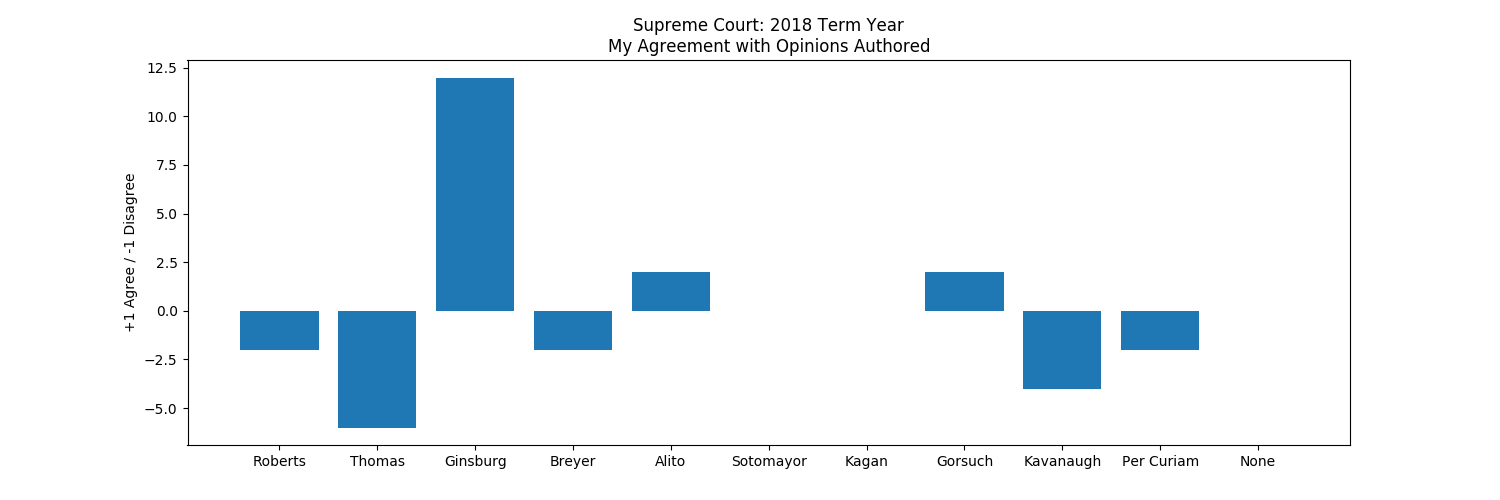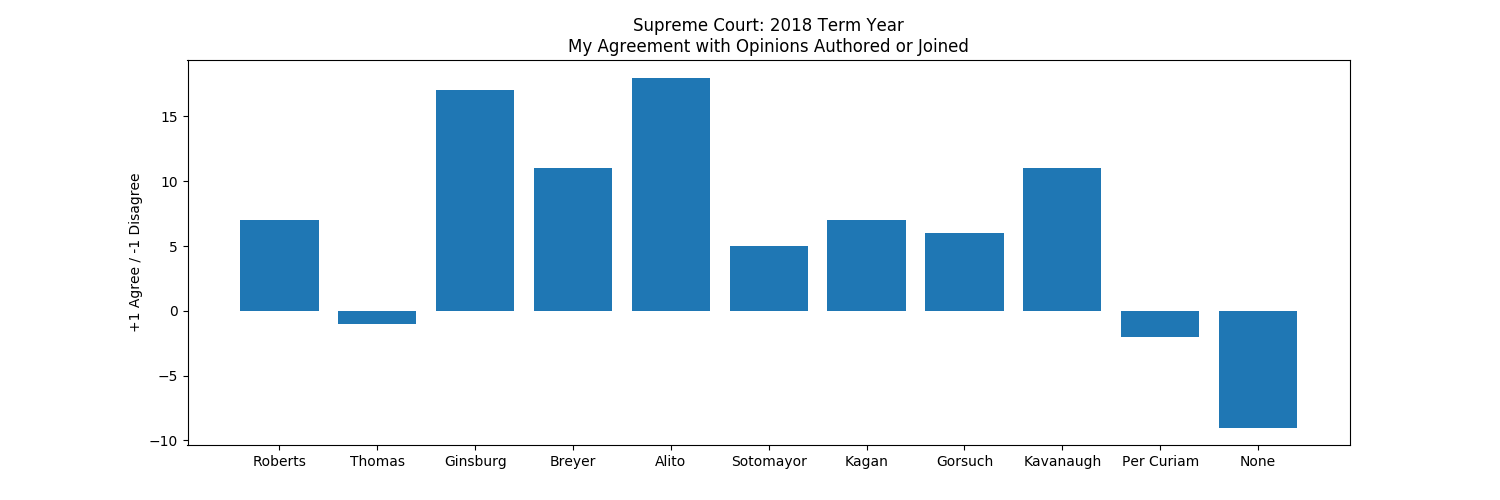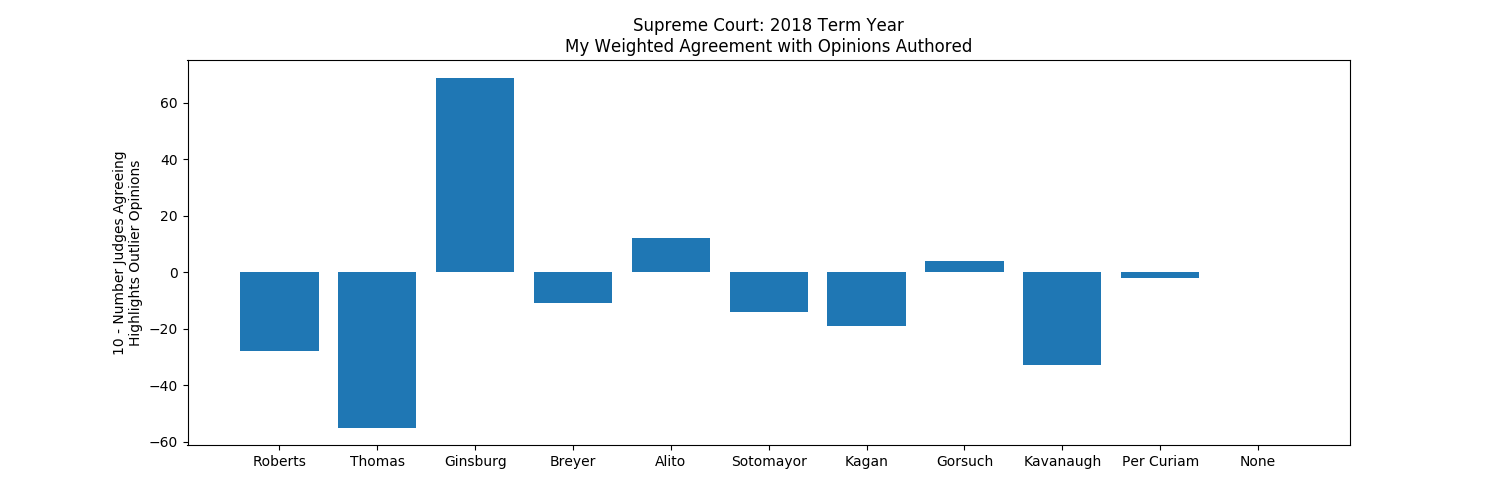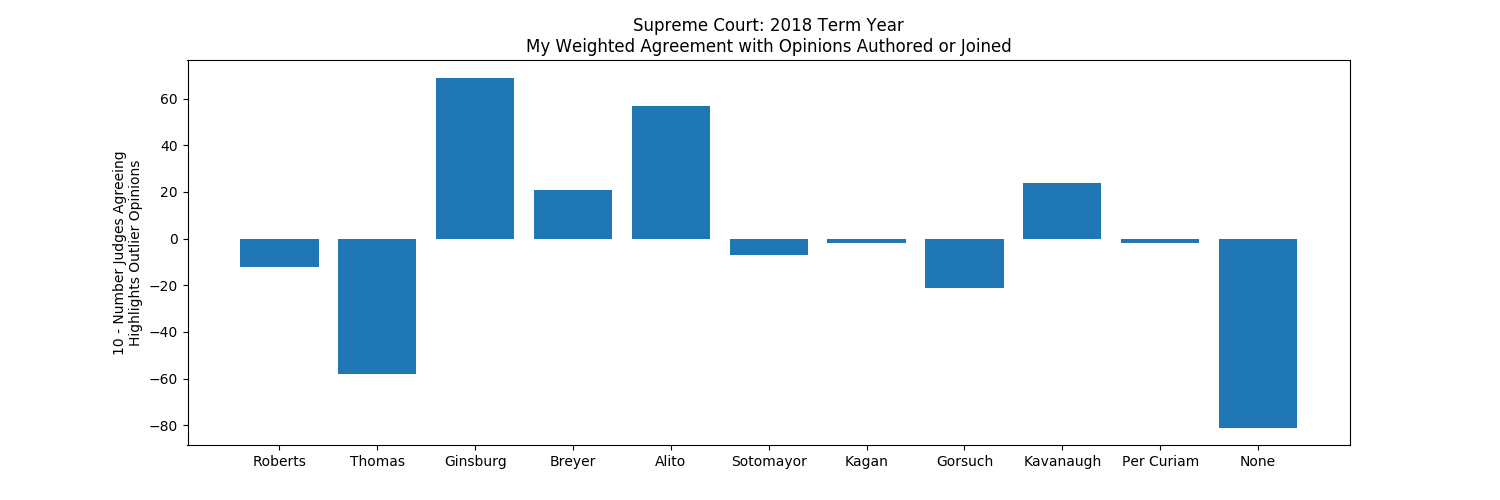The Code For This Page
2018_judges_analyze_A4.txt
2018_judges_analyze_A4_weighted.txt
Can you remember the cards you held the last time you played Bridge or Poker? And that of your opponents?
Well, I can't.
Nor am I completely confident about my coding ability... especially when I took a three week break in the middle, because, you know, you're not the boss of me. And if I don't feel like touching code, I don't feel like touching code.
Brett
Stuff
Judging the Judges
Term Year: 2018
2018 Term Year Analysis
Some Surprising Results
Check The Code
Do I Agree?
Authored Opinions
Surprising Results![Do I Agree? This is a graphical description of... Authored OrderedCounter(OrderedDict([('Roberts', -2), ('Thomas', -6), ('Ginsburg', 12), ('Breyer', -2), ('Alito', 2), ('Sotomayor', 0), ('Kagan', 0), ('Gorsuch', 2), ('Kavanaugh', -4), ('Per Curiam', -2), ('None', 0)]))](./images/2018_A4_authored_agree.png)
There were 168 Opinions Authored in the 2018 Term Year. And of those 168 Opinions, I Agreed with 84 and Disagreed with 84, which I am going to call some fairly even judging... others might disagree.
My mind splits the Above Graph into Four Groupings:
Ginsburg is the clear winner. I agree with her Authored Opinions more than any other Justice.
Alito and Gorsuch are tied for second, being at least positive.
Robers and Breyer are about equally negative.
While Thomas and (to a lesser extent) Kavanaugh tend to write things I disagree with.
Though, one can read too much into a Graph (or any statistical display).
Thomas Authored 28 Opinions, of which I Disagreed with 6 more than I Agreed with (meaning, I Agreed with 11 and Disagreed with 17). While Ginsburg Authored 14 Opinions, of which 1 Agreed with 12 more than I Disagreed (meaning, I Agreed with 13 and Disagreed with 1). Which if one wants to crunch the numbers a different way, means I only Agreed with Ginsburg two more times than Thomas. But then, I am not one, I am I. And that is not how I am going to interpret things.
I, clearly, really like what Ginsburg has to say (or at least, her Final Opinion on things), which is odd, as I would not have guessed such a thing.
My mind splits the Above Graph into Four Groupings:
Ginsburg is the clear winner. I agree with her Authored Opinions more than any other Justice.
Alito and Gorsuch are tied for second, being at least positive.
Robers and Breyer are about equally negative.
While Thomas and (to a lesser extent) Kavanaugh tend to write things I disagree with.
Though, one can read too much into a Graph (or any statistical display).
Thomas Authored 28 Opinions, of which I Disagreed with 6 more than I Agreed with (meaning, I Agreed with 11 and Disagreed with 17). While Ginsburg Authored 14 Opinions, of which 1 Agreed with 12 more than I Disagreed (meaning, I Agreed with 13 and Disagreed with 1). Which if one wants to crunch the numbers a different way, means I only Agreed with Ginsburg two more times than Thomas. But then, I am not one, I am I. And that is not how I am going to interpret things.
I, clearly, really like what Ginsburg has to say (or at least, her Final Opinion on things), which is odd, as I would not have guessed such a thing.
Do I Agree?
Authored Opinions & Opinions Joined
A More Comprehensive Comparison![Authored & Joining This graph shows my agreement with The Justices both in terms of the Opinions they Authored, but those they Joined, as well, graphing the following data... Authored & Joining OrderedCounter(OrderedDict([('Roberts', 7), ('Thomas', -1), ('Ginsburg', 17), ('Breyer', 11), ('Alito', 18), ('Sotomayor', 5), ('Kagan', 7), ('Gorsuch', 6), ('Kavanaugh', 11), ('Per Curiam', -2), ('None', -9)]))](./images/2018_A4_authored_join_agree.png)
In many ways, the above graph is more comprehensive than the previous. Any Justice who either wrote an Opinion with which I agreed or Agreed with an Opinion with which I Agreed received +1 for that Opinion. And conversely, if I Disagreed but they Authored or Agreed, they got -1.
If it's unclear how this differs from the previous, the previous just concerned my Agreement with an Authored Opinion, while this takes into account both Authored Opinions and Opinions Joined.
For instance, given that Thomas had more Solitary Decisions (per previous page, Decisions in which no one else Joined) and that I overwhelming Disagreed with most Solitary Decisions (the bar labelled None in the latest graph above, indicates solitary Opinions, regardless of author), one can (perhaps) find the major cause of my Disagreement with Thomas... more Solitary Decisions, which may be indicative (I certainly think that it is) of a willingness to take chances, to Author Opinions a step removed from the herd.
After all, this latest graph indicates a wide-spread agreement with The Court, as overall, I Agreed with 70 more Opinions than I Disagreed with (323 Agreed, 253 Disagreed).
Personally, I am surprised how much my Agreement with Alito differs from Thomas' or that I seem to feel the same way as Kavanaugh about many issues.
In rank order, I seem to prefer Alito, Ginsburg, Breyer, Kavanaugh.
If it's unclear how this differs from the previous, the previous just concerned my Agreement with an Authored Opinion, while this takes into account both Authored Opinions and Opinions Joined.
For instance, given that Thomas had more Solitary Decisions (per previous page, Decisions in which no one else Joined) and that I overwhelming Disagreed with most Solitary Decisions (the bar labelled None in the latest graph above, indicates solitary Opinions, regardless of author), one can (perhaps) find the major cause of my Disagreement with Thomas... more Solitary Decisions, which may be indicative (I certainly think that it is) of a willingness to take chances, to Author Opinions a step removed from the herd.
After all, this latest graph indicates a wide-spread agreement with The Court, as overall, I Agreed with 70 more Opinions than I Disagreed with (323 Agreed, 253 Disagreed).
Personally, I am surprised how much my Agreement with Alito differs from Thomas' or that I seem to feel the same way as Kavanaugh about many issues.
In rank order, I seem to prefer Alito, Ginsburg, Breyer, Kavanaugh.
Moving On
I was thinking that a Heat Map (an all-to-all comparison) would be next. But as there are one or two additional ways to slice the preceding (is +1/-1 the most appropriate weighting; and so on), I probably should look into those alternative interpretations first. I foresee a Heat Map as being fairly difficult. I doubt I will want to do it more than once.
And you know what?
Rather than creating another page for an alternative interpretation, I'm just going to carry on and hang a few more graphs here.
And you know what?
Rather than creating another page for an alternative interpretation, I'm just going to carry on and hang a few more graphs here.
Reverse Weighted
Giving Independent Thought Its Due![Do I Agree Authored Opinions - Weighted Do I agree with Justices Authored Opinions, giving more weight to outlier opinions, the data graphed OrderedCounter(OrderedDict([('Roberts', -28), ('Thomas', -55), ('Ginsburg', 69), ('Breyer', -11), ('Alito', 12), ('Sotomayor', -14), ('Kagan', -19), ('Gorsuch', 4), ('Kavanaugh', -33), ('Per Curiam', -2), ('None', 0)]))](./images/2018_A4_author_agree_weight.png)
This is very much like the first graph (at the top of this page). Only, instead of having weights of +1 or -1, I gave each Opinion +10 less the number of Justices that agreed with it.
This gave weight to outliers. And thus, the above graph is a better indication as to whether I agree with any given Justice's more outlandish opinions. It, also, sort of fades out those Justices who do not bother writing Unpopular Opinions.
1 Justice +9/-9
2 Justice +8/-8
9 Justice +1/-1
This gave weight to outliers. And thus, the above graph is a better indication as to whether I agree with any given Justice's more outlandish opinions. It, also, sort of fades out those Justices who do not bother writing Unpopular Opinions.
![Do I Agree Authored or Joined Opinions - Weighted As per above, but in addition to Authored it is Authored and Joining, do I agree with their Opinions based on their words and who they agree with, weighted towards outliers, the data graphed OrderedCounter(OrderedDict([('Roberts', -12), ('Thomas', -58), ('Ginsburg', 69), ('Breyer', 21), ('Alito', 57), ('Sotomayor', -7), ('Kagan', -2), ('Gorsuch', -21), ('Kavanaugh', 24), ('Per Curiam', -2), ('None', -81)]))](./images/2018_A4_author_join_agree_weight.png)
Using the same Weighting Scale as the previous, the above graphs shows the degree to which I agree with any Justice based on the Opinions they authored and those with which they agreed.
Clearly, I tend to agree with Ginsburg. I tend to disagree with Thomas. And it matters very much how one measures such things as to whether I tend to agree (or disagree) with Breyer and Kavanaugh.
In order to explore that last point in greater detail, let's stack the graphs all together, shall we?
Yes, I think we shall.
Clearly, I tend to agree with Ginsburg. I tend to disagree with Thomas. And it matters very much how one measures such things as to whether I tend to agree (or disagree) with Breyer and Kavanaugh.
In order to explore that last point in greater detail, let's stack the graphs all together, shall we?
Yes, I think we shall.
Comparative Analysis
These Are The Same Graphs As Previously Presented




The above four graphs each attempt to analyse the same base data: i.e. whether or not I agree with a given Jurist. But the graphs do not look identical.
Why?
My Models are different.
In this particular case, the Models differ because I can't make up my mind (as to which Model to use). Of course, it's all subjective. So, it really doesn't matter, anyhow.
But even if we were dealing with Hard Data it would be possible to achieve different results by using different models.
Hey! Do you like AI? That Machine Learning Crap? Multi-Variance Analysis?
A while back, I was looking at a tool to do just that. And a nice tool, it was. And it came with something like 80 Different Models... because who knows what your (or my) underlying data really looks like?
In fact, I've got a lot of graphs on this site. And this is not the first write-up in which I outputted essentially contradictory results (i.e. graphs, in this case).
The Model used is of supreme importance. And often, it is not possible to know which Model is correct.
But what I can say is the numbers don't lie (even if I just got done saying that they do). And it is clear I agree with Ginsburg more often than I had any idea.
Hmmm. Maybe there is a reason for that whole Cult of Ginsburg I mentioned a few pages back.
Why?
My Models are different.
In this particular case, the Models differ because I can't make up my mind (as to which Model to use). Of course, it's all subjective. So, it really doesn't matter, anyhow.
But even if we were dealing with Hard Data it would be possible to achieve different results by using different models.
Hey! Do you like AI? That Machine Learning Crap? Multi-Variance Analysis?
A while back, I was looking at a tool to do just that. And a nice tool, it was. And it came with something like 80 Different Models... because who knows what your (or my) underlying data really looks like?
In fact, I've got a lot of graphs on this site. And this is not the first write-up in which I outputted essentially contradictory results (i.e. graphs, in this case).
The Model used is of supreme importance. And often, it is not possible to know which Model is correct.
But what I can say is the numbers don't lie (even if I just got done saying that they do). And it is clear I agree with Ginsburg more often than I had any idea.
Hmmm. Maybe there is a reason for that whole Cult of Ginsburg I mentioned a few pages back.
Judging the Judges
Next Entry
Index
Go! Go! Ginsburg!
© copyright 2020 Brett Paufler
paufler.net@gmail.com
A Personal Opinion/Editorial